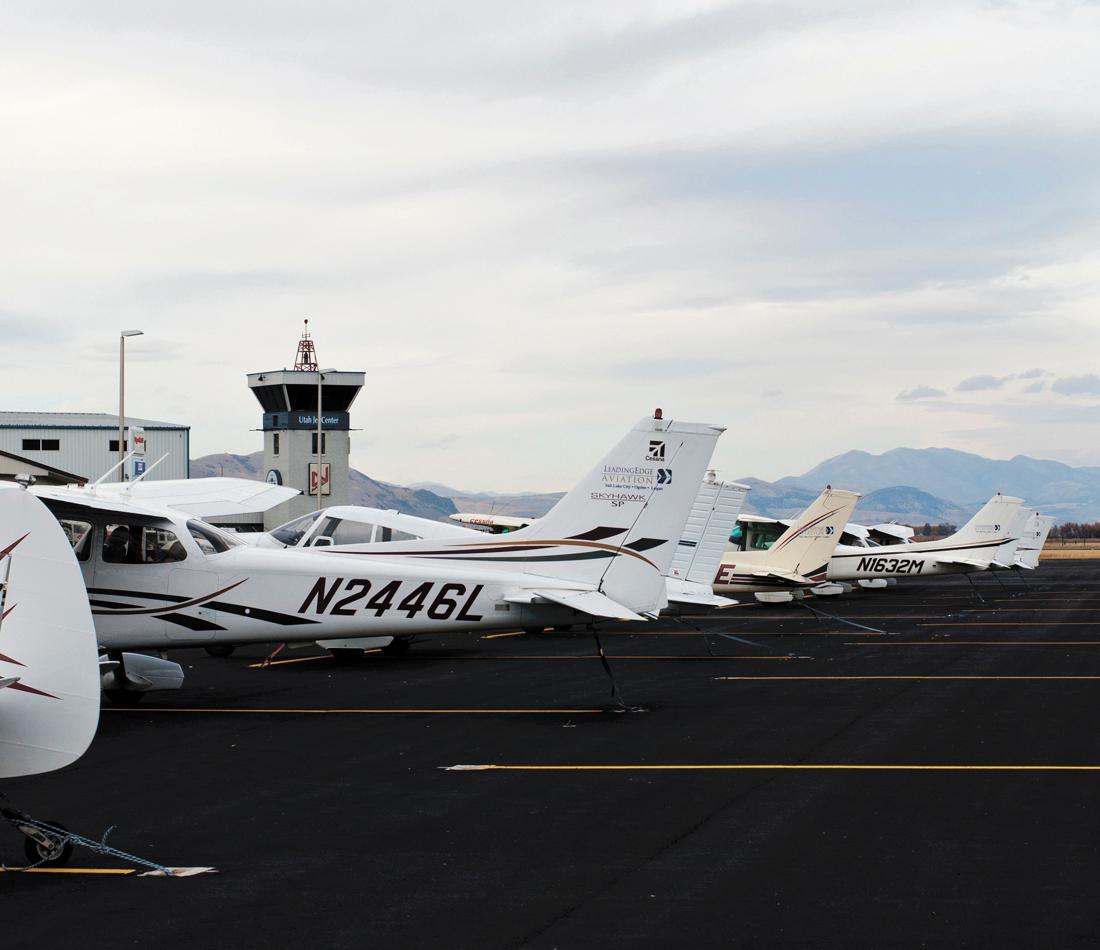Fly away home at the Logan airport
Just a 10-minute drive from Old Main sits the Logan-Cache Airport, home to three flight schools and the second-longest runway in Utah.
Six of the eight employees at Leading Edge Aviation, one of the flight schools at the airport, are graduates of Utah State University.
The university’s flight school offers a four-year degree in either Aviation Professional Pilot or Maintenance Management, according to the USU Aviation website. A large percentage of those professional pilots and maintenance managers are now employed by the likes of Skywest and Delta.
“We have a lot of folks who have come through our program who are in the field flying,” USU Aviation staff assistant Pam Allen said. Allen used to work in the USU football office.
“In the football office I had three quarterbacks and here I have 200,” she said.
Allen said pilots must have a certain degree of confidence because they are taking a plane into the air, which is not something everyone can do. Passengers do not look to stewards or stewardesses, but to the trained pilot for their well-being and protection, she said.
“We tend to draw the students that are a little higher caliber,” Allen said. “If you’re struggling in your classes at university, you’re going to struggle in our program.”
She said the University flight program shares the same high standards as the Federal Aviation Administration.
To become a pilot, one must follow a series of steps. First, obtain a private pilot’s license. Next is instrument rating.
“Kind of a flying in the clouds idea,” said USU graduate and Leading Edge Aviation line manager Nick Thomas.
The final steps are the commercial rating and then the option to become a certified flight instructor. With a commercial rating, a pilot can be legally hired and compensated.
Once the commercial rating is reached, a pilot has logged about 300 hours in the air. Most commercial airlines don’t hire pilots with fewer than 1,500 hours, Thomas said.
“The main principle behind it is you’re building time for the next level,” Thomas said. “It’s all about how much time you have flying and your experience in that sense.”
Thomas grew up in Albuquerque, N.M. and decided on USU because he wanted to be involved in both the flight program and Army ROTC. He later decided he wanted the future option of law school and switched to a pre-law degree.
However, because of his involvement in the USU branch of the Logan-Cache airport, he was familiar with Leading Edge Aviation and continued his flight education there.
“From the time I was a kid, I wanted to be a pilot,” Thomas said. “The desire to continue to fly has always been the driving factor.” Thomas is currently working on his ratings in order to become a flight instructor.
Though Leading Edge Aviation is one way to complete all the steps of becoming a pilot, the four-year degree offered through USU provides the diverse personality that Allen said is necessary for pilots.
“You have to be well-rounded,” Allen said. “A lot of our students are involved in other service clubs so they’re getting a really well-rounded personality to go into the cockpit.”
USU Aviation Recruiter Ray Zelenski also stressed how essential the traditional four-year degree flight program is. He described one course, for example, that studies how the human body reacts to various situations and called it exciting and vital for pilots.
“We’re the oldest university in Utah with a flight program,” Allen said. “We’ve been training pilots since World War II.”
Zelenski said the airport has a zero-accident record and they own their own airplanes, which he said is unusual. USU graduate Jabin Evans said the airport is uncontrolled, no one is in the tower.
Every pilot is responsible for themselves. Both Zelenski and Allen credited chief of aviation maintenance Steve Barton with the successful safety record. Barton has been with the USU Aviation program for 15 years.
“(Barton) is responsible for the safety of those planes,” Zelenski said of Barton. “Without him, we would not be where we are today in terms of safety. That is part of why we are so successful and so safe.”
After 9/11, aviation took one of the hardest hits economically, Thomas said. However, pilots are required to retire once they are 65 years old. Because so many pilots are veterans of Vietnam, they are reaching that ceiling of 65 years. As a result, there is a huge shortage and demand for pilots, Allen said.
“Anyone involved with aviation today is the purest at heart,” Thomas said.
There is no questioning that aviation training is expensive. Allen said there several thousands of dollars in fees for flight school on top of those of a normal student. Students must be willing to sacrifice to get loans and scholarships for the program. Still, in terms of program costs, USU Aviation is in the bottom-third of what university programs cost nationwide, Zelenski said. Thomas compared the cost of flight school to the cost of getting a master’s degree.
“People are doing it every day,” Thomas said. “The minute you get up and fly, you find a way. You make it happen.”
Evans wanted to be a pilot since seventh grade when he realized it was an option. He graduated from the USU Aviation program in May 2009 and is currently finishing his ratings to become an instructor for instrument rating students. The best part?
“I get paid to do this. This is my job,” Evans said.
The airport offers a Discovery Flight program for those who would like to see if aviation is their true calling. The Logan-Cache airport is located at 2850 Airport Road in Logan.
– noelle.johansen@aggiemail.usu.edu

